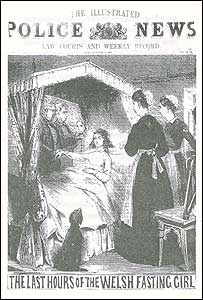Food Studies features the voices of 11 volunteer student bloggers from a variety of different food- and agriculture-related programs at universities around the world. You can explore the full series here.
 I don’t mean to brag, but this week, I had a particularly awesome reply to the inevitable question about what you actually study in a Food Studies program: “Well, this week, I graphed and analyzed data on organic livestock in New Jersey from 2000 to 2008, read and discussed the history of anorexia nervosa, and styled and photographed an Oktoberfest editorial.”
I don’t mean to brag, but this week, I had a particularly awesome reply to the inevitable question about what you actually study in a Food Studies program: “Well, this week, I graphed and analyzed data on organic livestock in New Jersey from 2000 to 2008, read and discussed the history of anorexia nervosa, and styled and photographed an Oktoberfest editorial.”
Of those three, though, it has been reading Fasting Girls: The History of Anorexia Nervosa, by social historian Joan Jacobs Brumberg, which has (unexpectedly) captured my interest. The book maps out the history of food refusal by women, from saintly religious figures like Catherine of Siena to the anorexia “boom” of the early ’90s with a focus on the “fasting girls” of the Victorian era. Our class discussion, with professor Krishnendu Ray, focused on the intense way that morality has been, and still is, wrapped up in eating — and, consequently, in not eating.
There is a rich history of public displays of food refusal centered around questions of piety and morals, from hunger strikes to religious fasts. Girls like Sarah Jacob , Mollie Fancher, and Ann Moore, who were said to abstain totally from food and to miraculously “live on air,” became celebrities in the 19th century for their supernatural gift, as clergymen, doctors, journalists, and curious onlookers (often with gifts and cash) gathered round their beds in awe. These women existed in moral limbo, as religious leaders praised their otherworldly devotion to the fast, and a growing medical field worked to scientifically disprove their perceived fasting and reveal the girls as money-hungry imposters.
For middle and upper-middle class Victorian families, diet was a moral issue. Government imperatives pointed to the importance of eating a balanced diet of clean foods, and as mothers were freed from the labor of cooking by smaller families, food abundance, servants, and technology, meals themselves became increasingly complex and important. The family table became the moral center of a home, as a place to impart etiquette, to regulate the family, and to serve good healthy meals. Girls were encouraged to eat light foods, sparingly, in accordance with their perceived delicate physiology and the era’s “cultivation of fragility.” Meat, fatty foods, and overeating were associated with sexual carnality, and so they were restricted from the diets of Victorian girls. Because of the importance of family meals, girls who refused to eat, as well as girls who ate too much of the “wrong” foods, had the power to disrupt entire households.
All of these moral questions are still tied up in what and how we eat.
Our morals can be — and are — judged by whether or not we think eating meat is acceptable, and, if it is, how it was raised. The literature of the “obesity epidemic” is fraught with questions of morality and responsibility. Obese people are vilified as lacking self-control and characterized as a strain on their community due to the rising costs of health care for obesity-related disease. Doctors accuse parents of obese children of child abuse. A healthy diet is not only a moral responsibility to ourselves, but something we owe our country, according to First Lady Michelle Obama, speaking at the launch of her Let’s Move initiative: “The physical and emotional health of an entire generation and the economic health and security of our nation is at stake.”
Most recently, New Jersey Governor and potential presidential hopeful Chris Christie is feeling the squeeze of the moral assumptions bound up in eating and weight, as pundits ask, “Is Chris Christie too fat to be president?” In his controversial op-ed in the Washington Post, Eugene Robinson argued that his discussion of Christie’s weight is not due to a superficial cultural bias against fat people, but rather a legitimate concern over a health issue that could render him unable to lead.
As a student in a program that is so tightly focused on the obesity epidemic as an issue of socio-economics and public health, reading Fasting Girls has been a helpful reminder to me to take a step back from the data to think about the language we use to frame food and eating, and the way that language of morality has been harmful in the past. If there is one thing that all of my studies in food have taught me, it is that problems like obesity in America are complicated. The more I learn, the less the moral imperative of “thin is good, fat is bad” is a satisfying response. If we are going to work towards a better-fed, healthier nation it seems that there is little room for moral binaries, stereotypes, and shame.



